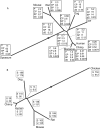A phylogenomic study of human, dog, and mouse
- PMID: 17206860
- PMCID: PMC1761043
- DOI: 10.1371/journal.pcbi.0030002
A phylogenomic study of human, dog, and mouse
Abstract
In recent years the phylogenetic relationship of mammalian orders has been addressed in a number of molecular studies. These analyses have frequently yielded inconsistent results with respect to some basal ordinal relationships. For example, the relative placement of primates, rodents, and carnivores has differed in various studies. Here, we attempt to resolve this phylogenetic problem by using data from completely sequenced nuclear genomes to base the analyses on the largest possible amount of data. To minimize the risk of reconstruction artifacts, the trees were reconstructed under different criteria-distance, parsimony, and likelihood. For the distance trees, distance metrics that measure independent phenomena (amino acid replacement, synonymous substitution, and gene reordering) were used, as it is highly improbable that all of the trees would be affected the same way by any reconstruction artifact. In contradiction to the currently favored classification, our results based on full-genome analysis of the phylogenetic relationship between human, dog, and mouse yielded overwhelming support for a primate-carnivore clade with the exclusion of rodents.
Conflict of interest statement
Figures


Comment in
-
Dog as an outgroup to human and mouse.PLoS Comput Biol. 2007 Apr 27;3(4):e74. doi: 10.1371/journal.pcbi.0030074. PLoS Comput Biol. 2007. PMID: 17465673 Free PMC article. No abstract available.
Similar articles
-
Dog as an outgroup to human and mouse.PLoS Comput Biol. 2007 Apr 27;3(4):e74. doi: 10.1371/journal.pcbi.0030074. PLoS Comput Biol. 2007. PMID: 17465673 Free PMC article. No abstract available.
-
Phylogenomics and the number of characters required for obtaining an accurate phylogeny of eukaryote model species.Bioinformatics. 2004 Aug 4;20 Suppl 1:i116-21. doi: 10.1093/bioinformatics/bth902. Bioinformatics. 2004. PMID: 15262789
-
Conflict among individual mitochondrial proteins in resolving the phylogeny of eutherian orders.J Mol Evol. 1998 Sep;47(3):307-22. doi: 10.1007/pl00006389. J Mol Evol. 1998. PMID: 9732458
-
Origin, genetic diversity, and genome structure of the domestic dog.Bioessays. 1999 Mar;21(3):247-57. doi: 10.1002/(SICI)1521-1878(199903)21:3<247::AID-BIES9>3.0.CO;2-Z. Bioessays. 1999. PMID: 10333734 Review.
-
Analysis of evolution of exon-intron structure of eukaryotic genes.Brief Bioinform. 2005 Jun;6(2):118-34. doi: 10.1093/bib/6.2.118. Brief Bioinform. 2005. PMID: 15975222 Review.
Cited by
-
Unconstrained mining of transcript data reveals increased alternative splicing complexity in the human transcriptome.Nucleic Acids Res. 2010 Aug;38(14):4740-54. doi: 10.1093/nar/gkq197. Epub 2010 Apr 12. Nucleic Acids Res. 2010. PMID: 20385588 Free PMC article.
-
Direct comparison of canine and human immune responses using transcriptomic and functional analyses.Sci Rep. 2024 Jan 26;14(1):2207. doi: 10.1038/s41598-023-50340-9. Sci Rep. 2024. PMID: 38272935 Free PMC article.
-
Loose ends: almost one in five human genes still have unresolved coding status.Nucleic Acids Res. 2018 Aug 21;46(14):7070-7084. doi: 10.1093/nar/gky587. Nucleic Acids Res. 2018. PMID: 29982784 Free PMC article.
-
Integrating overlapping structures and background information of words significantly improves biological sequence comparison.PLoS One. 2011;6(11):e26779. doi: 10.1371/journal.pone.0026779. Epub 2011 Nov 10. PLoS One. 2011. PMID: 22102867 Free PMC article.
-
Concise Review: Developing Best-Practice Models for the Therapeutic Use of Extracellular Vesicles.Stem Cells Transl Med. 2017 Aug;6(8):1730-1739. doi: 10.1002/sctm.17-0055. Epub 2017 Jul 17. Stem Cells Transl Med. 2017. PMID: 28714557 Free PMC article. Review.
References
-
- Archibald JD. Timing and biogeography of the eutherian radiation: Fossils and molecules compared. Mol Phylogenet Evol. 2003;28:350–359. - PubMed
-
- Archibald JD, Deutschman DH. Quantitative analysis of the timing of the origin and diversification of extant placental orders. J Mammal Evol. 2001;8:107–124.
-
- Arnason U, Gullberg A, Janke A, Xu X. Pattern and timing of evolutionary divergences among hominoids based on analysis of complete mtDNAs. J Mol Evol. 1996;43:650–661. - PubMed
-
- Shoshani J, McKenna M. Higher taxonomic relationships among extant mammals based on morphology, with selected comparisons of results from molecular data. Mol Phylogenet Evol. 1998;9:572–584. - PubMed
-
- Murphy WJ, Eizirik E, Johnson WE, Zhang YP, Ryder OA, et al. Molecular phylogenetics and the origins of placental mammals. Nature. 2001;409:614–618. - PubMed
MeSH terms
LinkOut - more resources
Full Text Sources

